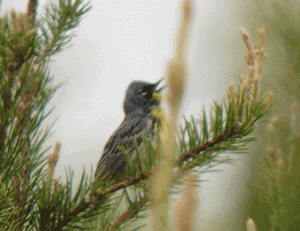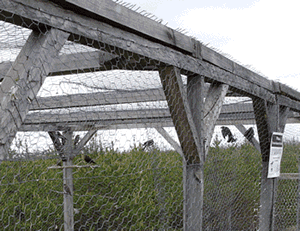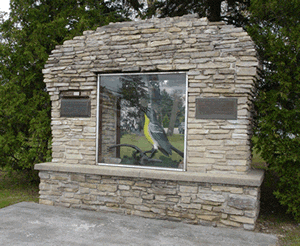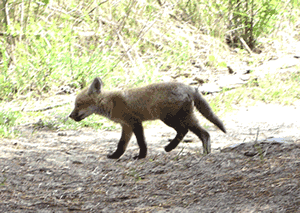After a long drive north, we made it to Gaylord, Michigan this morning at 1 am. We came to see the endangered Kirtland’s Warbler, one of the rarest birds in the States. It only breeds in a small area in northern Michigan, so if you want to see it, this is where you come. You can only view its breeding grounds on official tours run by rangers, and we met ours this morning at 11 am at a hotel in Grayling, a little south of Gaylord. We had two guides, the master (Chris) and the apprentice (Sean). The viewing season started today, so Sean was just learning the ropes. There was just one other birder on the tour, so we made a three-car convoy to the site.
Once we got there, we piled out of our cars and started the trek into the fields. The Kirtland’s nests only in jack pines, and young ones at that. So basically, you’re walking through cultivated fields of young pines (6 to 16 feet high), watching and listening for the bird. We heard them frequently as we walked, but seeing them was another story. But after about an hour of searching, we saw the KIRTLAND’S WARBLER — or at least I did. Pole missed this one, but a few minutes later, another — or the same — bird showed up. It appeared on the other side of the two track, and, with three scopes between us, we all got a good look at it. I also got the photo above, which, if muddy, is good enough for an ID.
Seeing the bird broke things up, so we headed back to the cars. On the way back, Chris gave us a look at one of their cowbird traps. The Kirtland’s is not only picky about where it nests, it also has its nests parasitized by brown-headed cowbirds. The cowbirds aren’t native parasites, so the Kirtland’s, in all their warbly innocence, raise the insatiable cowbird chicks at the expense of their own yolk and white. These traps help restore the balance. The wardens put banded cowbirds in large mesh boxes, and other cowbirds join them by dropping down a narrow tunnel. And, like some feathered lobsters, they usually can’t find their way out. Every couple of days, one of the naturalists steps inside the cage and asphyxiates the newcomers with a thumb gently pressed to the old windpipe. Problem solved. Good thing the cowbirds don’t understand what’s going on, or there’d be some ugly fights over those legbands.
On our way back, Sean pointed out a CLAY-COLORED SPARROW. He also found a VESPER SPARROW for Pole. I must have been somewhere else, because I didn’t even know about it until we were in the car. Sean is a 19-year-old birding whiz who’s on the payroll of the Audubon Society. Sometimes Audubon gives money to the program; this year they gave staff. Chris wasn’t a birder, but he was a good naturalist and the one who found the warbler. He recommended that we next visit Tawas Point State Park, which is due east on Lake Huron. He also recommended that we check out the Kirtland’s Warbler monument in nearby Mio. We did, and it was pretty tacky, a big plastic thing encased in a glass shrine. Though it looks like something from a miniature golf course, apparently it was dedicated by Roger Tory Peterson himself.
The drive to Tawas Point was refreshing, because northern Michigan is in the North Woods, which is our favorite place. Tawas was nice, too: hardly any people and small enough that we were able to walk the whole park. Unfortunately, migration hadn’t seemed to hit yet. We saw lots of birds, but the only new ones were a BOBOLINK and a SAVANNAH SPARROW. An amazing sight was a flock of about 50 blue jays. We’d never seen so many together, and I didn’t even know they did that. Best sight of all, though, was a pair of fox kits relaxing outside their den. Mom and Dad were absent, and our presence didn’t seem to bother the little guys too much. I hope they learn to be a little more careful.
Good day. An endangered bird, a goofy monument, and some baby foxes.




